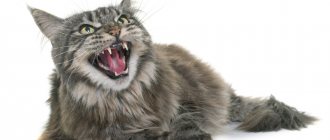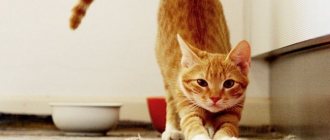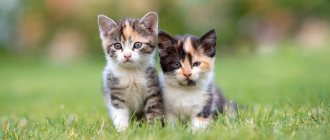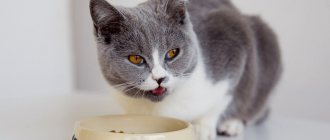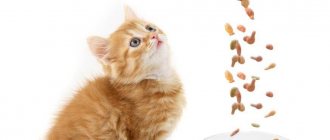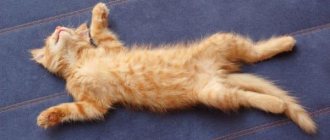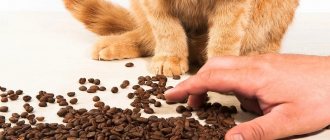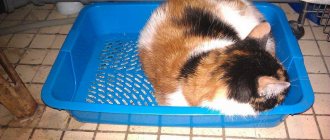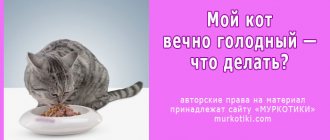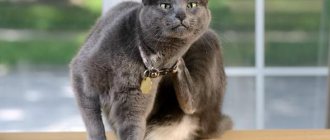Feed quality
Food, including dry food, is made from meat, but there is no way to preserve all its properties forever. Dry diet granules are treated with vitamin E; this is a useful and reliable preservative, but its validity period is limited and is approximately equal to the shelf life of the feed. Then the fats in the “drying” begin to decompose. The cat hears an unpleasant odor, feels a rancid taste and refuses to eat. The taste of canned food and spiders deteriorates in the same way after the expiration date. The answer to the question “why doesn’t the cat eat the food” can often be found in the “use before” line.
Cat won't eat new food
Even if you have chosen the ideal food for your cat, she may not immediately appreciate it. Indoor cats tend to experience stress from change, and sudden changes in diet put a strain on their digestive system. The situation becomes even more complicated when the new diet is not as varied as before - for example, if the pet needs to lose excess weight or prevent the development of allergies.
What to do. Study all the rules for switching to a new diet in advance. For this you will have to allocate at least seven days. During this period, you need to combine old and new food, monitor the temperature and texture of the food, and choose the right way to reward with treats.
Improper storage
Dry food loses flavor if kept outdoors. If your cat does not eat dry food that you bought in bulk, it may well be that the store did not carefully close the bag. For the same reason, you should not buy a year's supply for your pet: there is a high risk that you will have to throw away half of it. Opened canned food will only take a few hours at room temperature to become unusable. If you see that the cat has stopped eating wet food and has gone about his business, it is better to put the bowl with the leftovers in the refrigerator.
So, for what reasons can a cat refuse dry food?
1. Temporary loss of appetite due to illness, estrus, hot weather.
2. The bowl, as well as the place where it stands, is too dirty, and cats are clean animals.
3. Refuses due to problems with gums or teeth, as chewing granules is painful.
4. The animal had never tried dry food before, but ate natural products.
5. The cat also eats other food, as a result of which the feeling of hunger does not have time to manifest itself.
6. The food is of poor quality or contains unnecessary impurities that the animal does not like.
7. The product has deteriorated due to improper storage.
8. The cat is stressed, so she doesn’t eat, sleeps poorly, and hides in dark corners.
If, along with a reluctance to eat food, your mustachioed friend suffers from diarrhea, vomiting, and nasal discharge, then he is clearly sick. In this situation, you should definitely consult a veterinarian.
This is not the food
As we said, the cat's olfactory system reacts to animal proteins and fats in food, sending signals to the brain that this is the most suitable food for them. If dry food is poor in meat components, and vegetable fats are used instead of animal fats, then the cat may well refuse to eat it. After all, in nature cats do not eat grain, vegetables, mushrooms and nuts, and in most cases they only sniff flowers and grass and pass by. And even hunger doesn’t stop them from holding on tightly to their eating habits!
Therefore, cat food, of course, should consist primarily of meat rather than grain products, and then your pet will eat it much more willingly. In general, the advice is simple - change the food to one that meets the biological needs of cats as predators.
I didn't really want to
It happens that cats who simply are not hungry refuse dry food, because in the morning they already begged for cheese, in the afternoon for a bag of cat treats, and in the evening they feasted on the leftovers of dinner. Is it any wonder that the dry food in the bowl remains untouched, and it seems to the owners that the cat does not eat it at all.
The solution to the problem is to completely eliminate any treats, both in the form of treats and kibble from the table, and not give the cat any other food except dry food. Hunger is not a big deal!
How to train a cat to eat what they give?
The taste and smell of food is of great importance to cats. Therefore, when you switch your pet to a new type of food or a different brand of food, it is better to act gradually, rebuilding the diet over the course of a week. First, no more than 20% of the portion is replaced with new food. Then every day they increase its share, bringing it to 100%.
The cat feels the familiar aroma and is more willing to start eating. In addition, gradual changes in diet protect your pet from digestive problems during the adaptation period.
Unfortunately, this “canonical” method does not work with picky cats. Even with an almost homogeneous mass of food, they are able to discard small particles that they do not like. As a result, the granules of the new food remain in the bowl, and the animal walks around hungry and dissatisfied. Well, we'll have to resort to more drastic measures.
What to do
No method convinces your cat to eat wet food and you just don't know what to offer her? Here's what you need to know to change his mind and encourage him to eat.
When your furry doesn't want to go near the bowl of wet food, hope is not lost. There is always a solution. One strategy is to mix food: mixing dry food and wet food is a very effective way to attract your cat's face to food. However, you can add some of the sauce she likes to the food in the bowl to tempt her even more.
Flavoring his dish is a great remedy for his demanding palate. When changing the jar or bag, we try to add cat broth or sauce to his food, remembering to never use salt or spices that are harmful to his health. You can also choose jars of pate that are tastier and more attractive to your cat, as they have a creamy consistency.
The cat hardly likes to change its eating habits. Keep in mind that when an event occurs that disrupts his daily routine or his diet, in most cases there is distress or distress involved. If in any doubt, advice from a veterinarian is always useful and necessary. Together with a specialist, you can understand and help the cat in the best possible way.
Appetite decreases due to stress
The first thing new owners do is feed their pet. Having brought the kitten home, they pour him a whole bowl of food and expect him to immediately empty it. But at this time the baby is experiencing extreme stress: separation from his mother, moving to a new home, a complete change of environment. No wonder he has no time for food.
Take your time with feeding. Let the kitten explore the territory, come to terms with the separation, and get used to new people. If there are other animals in the house, keep them in another room for now. After an hour or an hour and a half, you can offer dry food: most likely, by this time the new pet will have worked up an appetite and will eat more willingly.
When to urgently contact a veterinarian
You can expect the condition to normalize on its own only if the cat feels well. Intervention is not required if the reason for refusal to feed is mild stress, selectivity or disruption of the daily routine. However, if uncharacteristic symptoms appear and prolonged fasting (more than 2 days for an adult cat, more than 6–12 hours for a small kitten), you must contact a veterinarian for examination.
An urgent visit to the clinic is mandatory in the following cases:
- The cat became dehydrated. It may appear due to vomiting, nausea, or refusal of water. The last symptom is the most alarming, since it indicates serious problems with the functioning of internal organs. Dehydration can kill your pet in a matter of hours due to blood thickening, so you should immediately contact your veterinarian for intravenous fluids. At home, it is allowed to inject Ringer-Locke solution into the withers, but it is better to first find out the cause of the ailment.
- The cat lies in one place, tries to stay closer to heat sources and reacts sluggishly to what is happening. In most cases, this indicates severe malaise and pain. Animals rarely complain of discomfort, since by their standards this is a weakness and can be fraught with death from the paws of another predator.
- The cat is behaving strangely. Sometimes pets meow pitifully, unable to withstand the pain or trying to communicate about it, but this is rare. Due to discomfort, the animal may ask to pet it or, conversely, not allow you to touch the problem area. Cats often become aggressive.
- The animal has a fever. The normal value for adult cats is considered to be +38…+39°C. In kittens, the temperature may be slightly higher - +38.5...+39.5°C. An increase of 1°C indicates the presence of inflammation, but is generally not life-threatening. If the temperature rises by 2°C, you should immediately consult a veterinarian. An increase of 3°C can be critical.
The most dangerous symptoms include vomiting, nausea, inability to empty the intestines or bladder for a long time (more than 2-3 days and 18-24 hours, respectively), disorders of the musculoskeletal system, etc. With itching, rash, For moderate diarrhea without dehydration and other mild manifestations, the cat can wait, but it is better to contact a veterinarian at the first opportunity, since even banal spots on the skin can indicate, for example, liver pathologies.
Food vagaries
Little kittens evoke affection and a desire to care. Everyone around is trying to treat them with something tasty, without thinking about the consequences. In fact, such “care” backfires on both the owners and the animal:
- the baby develops the habit of begging;
- food whims arise: the kitten does not eat dry food well, because it hopes for something “yummy”;
- nutrition is not balanced, which negatively affects the development of a growing body.
During the period of accustoming to dry food, it is recommended to exclude all treats and treats. Warn all family members about this so that they do not inadvertently violate your plan.
Lack of habit
Most often, a situation where a cat ignores dry food occurs if the animal was not accustomed to this product initially. At the same time, one should not conclude that the cat “considers” it to be unsuitable food; it’s just that, unlike wet foods, dry food smells different and has an unusual consistency.
All you need to do is get your pet used to a dry diet, starting with feeding food that the cat will eat with pleasure (this can be either canned pet food or a natural diet), and gradually adding dry food pellets to it.
At first, they should make up no more than 15-20% of the total serving volume, and then their number is gradually increased until complete replacement. On average, such a smooth transition takes one to two weeks.
If the cat is capricious and leaves dry food granules in the bowl, eating everything else, then you can act harshly by simply depriving the pet of any other food. A hungry animal will sooner or later start eating what is given.
Stabilize your condition
Decreased appetite in pets with various diseases is common.
This may happen due to:
- underlying disease
- side effects from medications
- stress
- weaknesses
The cat may completely lose its appetite, but most likely it will reduce its food intake or change its food preferences.
If there is a possibility that your pet may be experiencing nausea, discuss a solution to the problem with your veterinarian. It's difficult to get your cat to eat well if she's feeling nauseous.
Changing food during an exacerbation of the disease can lead to the fact that the cat associates the new food with poor health and refuses it in the future.
By improving your pet's well-being, you can more comfortably transfer him to a therapeutic diet.
Why does my cat no longer eat the food he used to eat?
Contents hide
Sometimes it happens that a pet does not want to eat its usual food, which just yesterday it was gobbling up both cheeks. Despite obvious hunger, the cat refuses to even approach the bowl. Do not rush to scold your pet and accuse him of being spoiled. The reasons for this behavior may be deeper.
The food has run out . Most often this happens with dry food. The attractive aroma of food is important to cats. Cats have trouble seeing in front of them, so they find food by smell. If the bowl does not smell of anything, it means it is empty and you should ask the person for food.
To prevent this from happening, keep bags and cans of food tightly closed. Also remember to check the expiration date. Expired food not only loses or changes its smell, but also becomes unsafe for your pet's health.
The owner forgets to wash the plate . Sometimes it happens the other way around: the bowl smells so bad that the cat simply doesn’t want to go near it. It is unlikely that the owners themselves would want to eat from dirty plates with flies circling over them.
Place food in a clean bowl, do not be lazy to throw out dried remains, wash and wipe the container dry. Compliance with the rules of hygiene promotes excellent appetite and prevents diseases, in particular intestinal disorders. Also, do not forget to wash the place where the bowl is – the tray or the floor.
Bad batch . The manufacturer may have a defect, for example, the food was prepared from low-quality raw materials. The recipe may also change. Cats are sensitive to smells and will immediately understand that food is spoiled or smells different, unusual. Cats are conservative, so they may not like the new consistency - too liquid or, conversely, too coarse and viscous.
Try buying food elsewhere or the same brand but with a different flavor. Don't forget about the expiration date. It is also not recommended to take loose dry food. Sellers pour it out of large bags in which the granules are stored for who knows how long. Perhaps the food simply dried out or, on the contrary, became damp and tasteless. Buy the same food, but in a sealed commercial package. The cat will probably like it more.
The cat is sick . Observe how your pet behaves at the bowl. If it fits, starts eating and immediately leaves, it is recommended to check the gums and teeth. Perhaps it hurts the cat to chew and that’s why he stops. If the teeth are in order, you should pay attention to the toilet: the cat may have indigestion.
The worst thing is if the cat ignores food altogether and sleeps a lot. Most often, this behavior indicates illness - from headaches to tumors. In this case, be sure to show the cat to the veterinarian.
The cat was spoiled . Yes, this can happen too. If, in addition to food, you like to feed from the table, give a lot of treats and delicacies, get ready for the periodic whims of your pet. The cat knows that in addition to the usual “banal” food there is a lot of other tasty things, and he will not refuse a tasty addition.
Try not to overfeed your pet with delicacies. Wean you off the table and eating from your hands immediately (or better not at all). The cat should eat food that is suitable for its age, health and weight. An unbalanced diet and “bite eating” lead to indigestion, allergies, weight gain and behavioral problems.
Photo source:
Bad food
When an animal does not eat dry food well, sometimes the reason lies in the quality of the product itself. Perhaps it is not tasty enough or spoiled. Cats are obligate carnivores and are most attracted to meat, so it is important to choose food with a high content of it. Acana and Orijen diets consist of 75–85% meat ingredients and other animal products (fish, eggs, innards). This is an excellent choice both for raising kittens and for maintaining the body of an adult cat.
Don't forget that even the highest quality food can be spoiled if it is expired or stored incorrectly. Cats, like other animals, have an innate ability to distinguish healthy and safe food from harmful and inedible food. If the fats in the food have oxidized, a person may not feel it, but the kitten will not eat such food, and rightly so. The owner will have to purchase fresh packaging of food and store it properly in the future.
